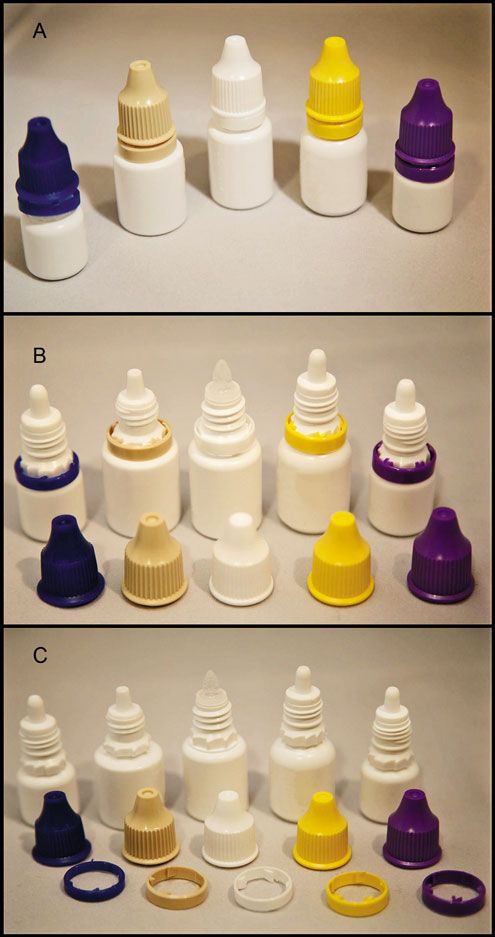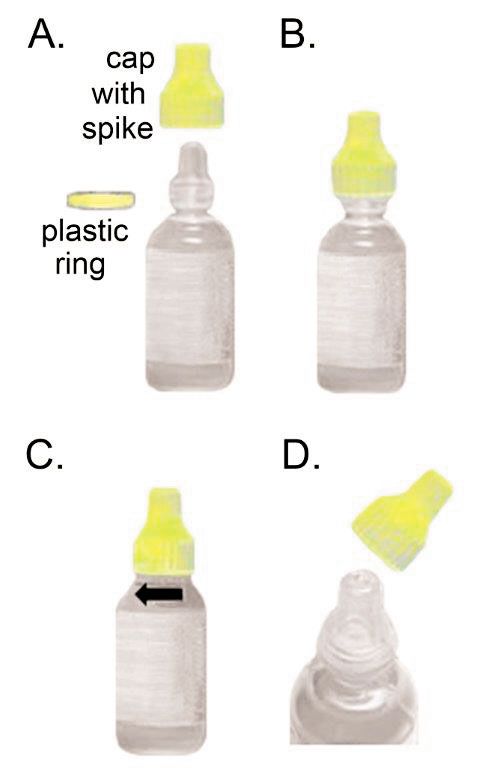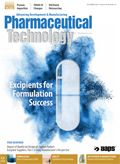Ophthalmic Drug Packaging: Safety Risks and Patient Acceptability Issues
The authors describe some cases of container closure design flaws and actions taken by FDA to mitigate safety risks and increase patient acceptability.
kokouu/E+/getty images

Many ophthalmic diseases and eye irritations are treated with topically administered drug products. More than 70% of ophthalmic drug products are simple solutions supplied in multi-dose plastic container closure systems (CCS), which generally contain a month or longer supply of the drug. These products may be intended for the treatment of acute or chronic conditions. The typical multiple-dose CCS for liquid ophthalmic drug products is comprised of a bottle, a drug-dispensing tip, cap, and overseal or other tamper-evident feature. These packaging components are regulated by FDA’s Center for Drug Evaluation and Research (CDER) (1). They function together to protect the quality of the drug product, maintain product sterility through initial breakage of seal by patient, aid dosing and administration, and minimize product contamination throughout the duration of its use. As a result, ophthalmic drug product packaging is considered to be relatively more crucial to product performance and safety than the packaging used for solid oral drug dosage forms.
Many CCS manufacturers and suppliers offer designs with unique features (which, in some instances, are patented), which adds to the complexity of ophthalmic product packaging. Due to these differing CCS designs among manufacturers, substitution of a brand-name or Reference Listed Drug (RLD) by a generic drug, or switching between different generic versions of a drug product, can lead to unnecessary confusion and patient risk. This article examines five case studies illustrating these issues. The first two involve patient safety, due to a risk of localized, external eye injury from particular packaging design flaws. The others show difference in patient acceptance, due to differences between the RLD and the substituted generic-drug packaging performance with respect to bottle/cap torque specifications, piercing of the dropper tip, and consistent delivery of the intended drug dosage/volume.
Case study one: Tamper-evident ring feature
One recent safety concern discovered during post-market review involved the use of non-retaining plastic tamper-evident rings (i.e., collar or band) to seal the bottle and cap (Figure 1). When the patient twists off a new bottle cap for the first time, he or she breaks the connections between the ring and cap, thereby providing visible evidence that the bottle has been opened.
Figure 1: Eye drop bottles with nonretaining tamper-evident rings. (A) Many different container closure venders supply these bottle and cap configurations. (B) The container closure system design is not engineered to secure the plastic ring around the bottle neck. As a result, the plastic rings are likely to slip off the bottle neck on patients’ eyes when the bottle is inverted to administer eye drops. (C) The sharp ridges on the rings formed when the seal is broken between the cap and ring can cause corneal abrasions. FDA recommends that these designs of ophthalmic bottles include a positive-retention mechanism to prevent the rings sliding off during product use. (Courtesy of authors)

The plastic tamper-evident ring sits around the base of the bottle neck after the cap has been removed. Unless the bottle has been designed to prevent it from slipping down the neck of the bottle, this loose plastic ring can fall off when the bottle is inverted to deliver the eye drop(s). Consumers have complained to FDA that the tamper-evident ring has fallen on patients’ eyes during administration of the drug product, causing eye irritations and injuries. In certain cases, the sharp plastic spikes that result when the bridges between the cap and seal are broken, have scratched patients’ corneas.
FDA is in the process of identifying all branded and generic ophthalmic drug products packaged in bottles with non-retaining tamper-evident rings, and has issued a safety alert (2). This alert recommends that applicants either change the CCS design or redesign the bottle neck and ring so that they are similar to those present on disposable plastic beverage bottles such as water or soda bottles, to prevent the tamper-evident ring from coming off the bottle while in use.
In response to the risks of eye injury, some applicants have proposed packaging label changes that would instruct patients to remove the tamper-evident ring from the bottle neck prior to administering eye drops. Such labeling changes, however, are undesirable, because they will promote more manipulation of the product bottle and increase the likelihood that the patient will accidentally touch the drug dispenser tip, leading to contamination of the drug. The proposed labeling change may also contradict other labeling information that instructs patients to avoid contaminating the dispenser tip by touching it with their fingers or allowing it to come in contact with one’s eyes, face, or other surfaces.
Tamper-evident packaging is a specific requirement for over-the-counter (OTC) drug products and ophthalmic preparations that are regulated as medical devices (e.g., contact lens solutions) to prevent adulteration of products accessible to the public during retail sale (3). Although prescription ophthalmic drug products have traditionally used a shrink-wrap-type bottle seal for products held behind the pharmacy counter, many applicants have proposed the use of tamper-evident seal technologies for prescription ophthalmic products. It is recommended that, in cases where tamper-evident rings are proposed for ophthalmic products, there should be a positive retention mechanism built into the CCS design to secure the rings.
Case study two: Shedding of plastic particles
Recently, consumers have also complained that foreign particles have entered patients’ eyes while applying multiple sterile ophthalmic ointments, which has resulted in such adverse events as eye irritations, pain, ocular discomfort, and superficial eye injury. These types of injuries have been associated with small pieces of plastic or plastic particle shavings from the CCS. In one particular case, unscrewing the cap from the ophthalmic tubes caused the cap to shed plastic particles. Root cause analysis (RCA) by the ophthalmic tube supplier determined that the defect was related to over torqueing or a slight cap tube misalignment during the capping process, which required the tooling equipment to be adjusted. The drug-product manufacturer chose to recall specific lots of affected drug products in response to consumer complaints. FDA’s MedWatch system continues to monitor product quality cases like these given the frequency of complaints about particles shedding in patients’ eyes when using a variety of ophthalmic drug products.
Case study three: Patient-packaging interface issues with overly tight bottle closures
This case illustrates challenges that patients experienced when opening bottle caps and/or seals in ophthalmic products. Ophthalmic product bottles are significantly smaller than beverage bottles, and extra effort is often required to twist off their caps because of the limited surface area available for gripping and manipulating the bottle and cap. This issue becomes amplified if the drug product is intended for use by elderly patients or patients with reduced dexterity.
In one particular case, there were numerous consumer complaints that caps had been screwed too tightly on ophthalmic bottles. Post-marketing evaluation studies confirmed the difficulty in opening the bottles, and FDA asked the manufacturer to revise the torque specifications for the drug product CCS to enable easier cap opening. The applicant’s initial strategy was to decrease the number of bridges between the cap and the sealing ring to reduce the torque for bottle opening. This approach failed, however, because the bridges prematurely broke during the capping process, deactivating the tamper-evident safety seal mechanism. The applicant responded by using a different plastic resin to make the cap, and conducted a mechanical bridge breakage torque investigation, followed by human in use qualification studies on bottles that had been fitted with caps manufactured with the new resin. Use of the new cap resulted in an easier, more patient-friendly cap-opening process that required less torque force to break the seal. The new cap resin was applied to the applicant’s entire ophthalmic product line, which successfully mitigated the patient/packaging interface issues associated with excessively tight bottle caps.
Case study four: Spike designs for piercing dropper tips
Also problematic are CCS designs that require multi-step procedures for piercing ophthalmic dropper tips. These designs appear to confuse patients. In one set of cases, a serious flaw in the CCS design featured a sealed bottle and a screw cap with a spigot (spike) on the inside of the cap. This design required that the patient or caregiver employ a multi-step process to deliver the eye drops (see Figure 2). First, they twist the cap, breaking the seal, and then the plastic ring is removed so that when the screw cap is returned to the bottle and tightened, the spike underneath the cap is positioned to pierce the dropper tip and create an aperture.
Figure 2: Multi-step process for opening the bottle and piercing the dropper tip. (A) This bottle/cap design features a spike on the inside of the cap used to pierce the dropper tip. The cap is unscrewed initially and the plastic ring is removed. (B, C) The cap is then returned to the bottle and tightened to allow the spike to pierce the dropper tip. (D) Removal of the cap reveals the aperture on the dropper tip. The procedures for piercing the bottle tip are confusing to the patient population and result in variable aperture sizes and lack of control in the drug dose delivered. FDA recommends that this type of spike design not be used for ophthalmic drug products. (Courtesy of the authors)

Due to the complexity of this multi-step piercing procedure, however, patients were confused about which procedure was required to create an aperture of the appropriate size. As a result some patients used knives and scissors to puncture the tip, which increased the risk of injury from use of these household tools. In addition, this design led to highly variable aperture sizes and significant differences in eye drop size and the volume of medication delivered to the eye. This variability also contributed to complaints that the drug product did not last through the prescribed period of use.
In an effort to mitigate this risk, the applicant revised the product labeling to include more explicit instructions and schematics on the carton and package insert so that users would create the aperture properly. These steps, however, did not solve the problem, and consumers, and prominent ophthalmology organizations, continued to note problems with the design. The applicant then redesigned the CCS, using a more traditional and intuitive approach (i.e., a single-step process for opening that does not require removal of the cap).
As a result of such cases, information requests are now typically issued to inquire whether or not the container closure tip is sealed until activation, on first opening by the patient. In cases where the seal tip is opened by activation, multi-step procedures that require removal of the cap are discouraged. Single-step procedures that involve simple, intuitive twisting without removal of the cap are generally preferred.
Case study five: Differences in volume of drug delivered
As mentioned earlier, proper sizing of the eye-dropper aperture is crucial in order to control the eye-drop volume and rate of eye drops dispensed when the bottle is inverted and gently squeezed. In a particular case related to eye-dropper performance, there were numerous patient complaints that the drug product did not last through the prescribed period of use. The generic-drug packaging was observed to release larger eye drops to the eye than the packaging that had been used for the RLD. Samples of the marketed drug products were tested, and the results showed that the generic product had a significantly larger eye drop size compared to the RLD (49.2 microliters versus 34.1 microliters). Generally, the average eye-drop volume for ophthalmic solutions is approximately 28 to 32 microliters. Although the generic product released significantly larger drop sizes than the RLD, this did not result in excessive drug exposure, because the volume exceeded the level that can be held in the cul-de-sac of the eye without overflowing, which is approximately 30 microliters (4). The excessively large drop size of the generic, however, did result in consumer complaints of inadequate supply, associated with the drug product not lasting through the month-long prescribing period.
Generic ophthalmic drug products are required to be pharmaceutically equivalent to the RLD, and, as part of this requirement, applicants of a generic ophthalmic product are expected to show that the drop size is not significantly different from that of the RLD. This is in line with a 2008 Citizen Petition response (5) stating that FDA reviews “drop size as part of the quality review to ensure that, when used by the consumer, the generic product will have comparable delivery characteristics [to the brand-name product].” Based upon these requirements and expectations, the applicant in this case agreed to replace the dropper tip to correct the differences in the dropper performance between the two CCS designs, resulting in a more comparable eye drop size to the RLD product. As a result of cases concerning differences in eye drop volume between the RLD and generic, it is FDA’s position that the drop size of the proposed drug product should not significantly differ from that of the RLD.
Conclusion
FDA/CDER’s Office of Pharmaceutical Quality (OPQ) focuses primarily on the quality review of container closure systems from the perspective of how the packaging components impact drug product’s critical quality attributes from the time of packaging through patient usage and treatment. In an effort to better manage patient risks and acceptability issues, FDA has been increasingly assessing the effects of patients’ handling or usability of the drug product until the last labeled dose is delivered by the CCS. FDA recommends that applicants consider the intended patient population when designing ophthalmic packaging, especially since the intended patient may be elderly with motor coordination difficulties, or may have certain medical conditions associated with impaired vision. This patient-centric focus is in line with broader FDA goals to link drug product quality attributes to patient acceptability in terms of objective and measurable outcomes.
The cases presented herein are general examples of container closure design flaws that may affect branded and generic drugs. In many cases, safety signals such as eye irritations, discomfort, and superficial eye injuries as a result of CCS quality defects are reported to the drug product manufacturers as adverse events. When drug manufacturers receive these market complaints concerning drug-packaging performance, they often propose revisions to labeling instructions to correct the noted issues with packaging. While this strategy may be quicker and easier to implement, labeling revisions are generally not appropriate substitutes to remedying packaging design flaws and should only be considered as temporary solutions under certain conditions. A more effective strategy should be a redesign or replacement of the faulty CCS components as part of the corrective action and preventative action (CAPA) plan.
Careful consideration of ophthalmic packaging performance attributes is crucial given the complexity of the CCS and the inherent risk of harm to the eye. Per
FDA guidance on drug product container closures (6), packaging components with ‘special’ functions should be qualified to show that they perform the intended function(s) properly. These include tamper-evident collars, specialty seals, and drug-delivery components, all of which are considered ‘special’ function components. FDA recommends that when a newly proposed or novel CCS is being submitted as part of the data package for a new drug application (NDA), abbreviated new drug application (ANDA), or supplemental NDA or ANDA, appropriate qualification is performed and data are provided for FDA review to support the usability and to assess risks with the proposed packaging components. This helps to ensure safety and consistency in packaging performance among the various CCS designs used for packaging of ophthalmic drug products marketed.
Acknowledgements
The authors wish to acknowledge CDER colleagues Susan Rosencrance, PhD, Frank Holcombe Jr., PhD, Pick-Wei Lau, PhD, Geoffrey Okelo M.Chem., MBA, and Keith Olin, PharmD for helpful discussions and advice while drafting this article. We would also like to thank the following additional colleagues in the Office of Regulatory Affairs (ORA) for providing information from FDA field inspections: John Diehl, Latorie Jones, Shelby Marler, Massoud Motamed, and Rebeca Rodriguez. Lastly, we would like to acknowledge FDA CDERdesignz for photographs of eye drop bottles.
Disclaimer
This article reflects the views of the authors and should not be construed to represent US FDA’s views or policies.
References
1. Code of Federal Regulations, Title 21, Food and Drugs (Government Printing Office, Washington, DC), Part 200.50 (c) Ophthalmic preparations and dispensers.
2. FDA Drug Alerts and Statements: FDA warns consumers about potential risk of using eye drops packaged in bottles with loose safety seals, 3/15/2016. www.fda.gov/Drugs/DrugSafety/
3. Code of Federal Regulations, Title 21, Food and Drugs (Government Printing Office, Washington, DC), Part 211.132 (b) Requirements for tamper-evident package.
4. D.S. Aldrich et al., “Stimuli to the Revision Process: Ophthalmic Preparations,” USP Pharm Forum 39 (5) (2013).
5. FDA/CDER to ISTA Pharmaceuticals-Petition Partial Approval and Denial. ID: FDA-2008-P-0368, www.regulations.gov.
6. FDA, Guidance for Industry: Container Closure Systems for Packaging Human Drugs and Biologics (Rockville, MD, May 1999).
Article Details
Pharmaceutical Technology
Vol. 40, No. 10
Pages: 44–51
Citation
When referring to this article, please cite it as K. Bernard et al., "Ophthalmic Drug Packaging: Safety Risks and Patient Acceptability Issues," Pharmaceutical Technology 40 (10) 2016.
